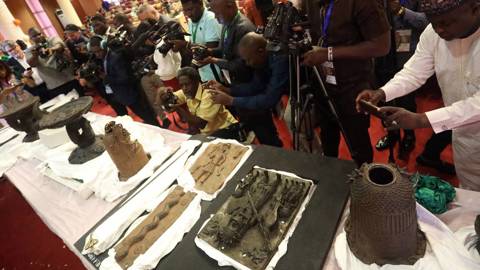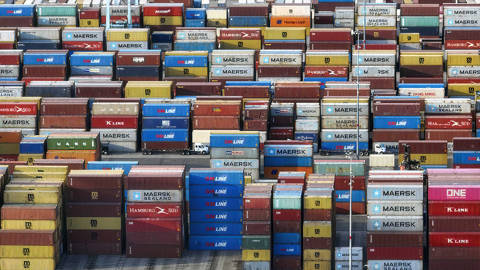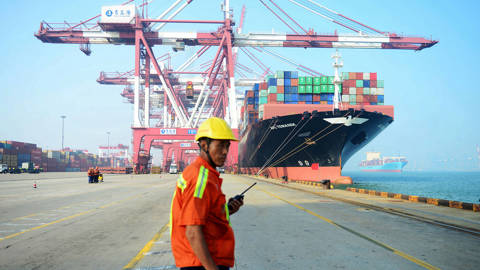When a senior defense expert recently testified before a US Congressional commission on China's military capability, he detailed the extraordinarily robust weapons program the People's Liberation Army (PLA) has been pursuing. He pointed particularly to the PLA's increasing number of short-, intermediate- and even long-range ballistic missiles. But the expert concluded that, despite the alarming number of missiles, they did not constitute a ``buildup.''
Baffled by that conclusion, the Congressmen began asking one question relentlessly: if the existing PLA missiles did not constitute a ``buildup,'' then what number of missiles would? The inability to answer this question clearly exorcised and angered both the senior expert and the committee.
But this episode illustrates a fundamental and frustrating problem: the more we know about what is going on in China the less we are sure about whether China has actually become a threat. We know China has doubled and redoubled its defense budget for, among other things, a massive weapons development program, including modernizing a deterrent and second-strike nuclear capability. Yet we cannot decide whether this build-up is menacing.
The prevailing consensus is not to regard China as a threat. But there are several serious conceptual flaws in this reasoning. It fails, for example, to take into account the hostile strategic culture against the US--and against US strategic goals in the Asian and Pacific regions-- that has long been ingrained within the PLA.
Moreover, a cursory glance at the PLA's readiness training, research and development, weapons acquisition, and indoctrination programs shows that Chinese officials are preparing to fight future wars not only against regional powers, but against a superpower. Its preparations focus not on parity with the US's modern weaponry, but on the development of ``asymmetrical warfare'' theory and capability. As the 9-11 terrorist attacks on the US brutally reminded us, a lethal threat need not come from equivalent military hardware.
The PLA has spent an inordinate amount of its rapidly growing resources in areas that give it an asymmetrical advantage, such as electronic warfare and human intelligence. Such tactics are aimed at confronting an enemy that is armed with the most advanced weapons systems, but is vulnerable to sabotage and asymmetrical attack, even latter-day guerilla warfare.
Throughout the PLA's history, a chief tactic has always been to launch asymmetrical attacks on an enemy's command and communication centers, thus obviating direct confrontations where parity in technological development would determine a clearer definition of victory and defeat. The PLA has never been deterred or become less aggressive when confronted with an enemy possessing more advanced hardware. This was true of Mao's guerrilla war against the Japanese occupation, the Civil War against Chiang Kai-shek's Nationalists, the Korean War against the US, and even the Vietnam War, where China backed the North.
More recently, PLA officials have been among the most interested observers of the two US-led Gulf Wars. They have been impressed by US technology and remote firepower, but they have also been searching for US military weaknesses in such a context. While awed by American hardware, some PLA brass are convinced that if Saddam Hussein had been a better commander, the battle for Baghdad could have been, to quote Zhang Zhaozhong of the Chinese National Defense University, ``George Bush's Stalingrad.''
One aspect often over-looked in foreign assessments of the PLA is its political indoctrination and the level of fanaticism this can create for an actual battlefield scenario. Despite all the years of stressing ``military modernization,'' the system of indoctrination by Political Commissars remains the soul of PLA units. We have seen the ferocity of ideologically intoxicated PLA soldiers during the Korean War, and even at Tiananmen Square in 1989.
Finally, China is far from being an Iraq or an Afghanistan. Despite the obvious imbalance with the US in terms of modern armaments, it would be shortsighted to ignore China's own formidable military hardware. It has a nuclear first- and second-strike capability; its own satellite communications systems; increasingly sophisticated and numerous aircraft and war ships; a rapidly growing economy to sustain high levels of military investment; as well as its own political and diplomatic points of leverage at places like the UN.
The supposition that China cannot become a threat in the near future, or in the next twenty years, is simplistic, because it ignores basic aspects of China's political system. The reality is that China has been through a half century of Marxist-Leninist revolutionary indoctrination, which emphasizes the predatory nature of imperialism, colonialism, and capitalism--with America singled out as the leader of oppressive global forces.
This ideology feeds a deep popular perception of China as a wounded, humiliated third-world victim and instills in the ruling Communist Party a powerful sense of unresolved grievance. It was from this mindset that Mao's theory of guerilla war--the last century's mother of all asymmetrical strategies of warfare--was born. It would be naive to assume that this mindset, which has become more deeply rooted in the PLA than anywhere else in Chinese society, is a thing of the past.
Whether China will prove to be a paper dragon of little military substance or a crouching tiger with sharp claws remains unresolved. But, as the saying goes, ``Eternal vigilance is the price of freedom.''










When a senior defense expert recently testified before a US Congressional commission on China's military capability, he detailed the extraordinarily robust weapons program the People's Liberation Army (PLA) has been pursuing. He pointed particularly to the PLA's increasing number of short-, intermediate- and even long-range ballistic missiles. But the expert concluded that, despite the alarming number of missiles, they did not constitute a ``buildup.''
Baffled by that conclusion, the Congressmen began asking one question relentlessly: if the existing PLA missiles did not constitute a ``buildup,'' then what number of missiles would? The inability to answer this question clearly exorcised and angered both the senior expert and the committee.
But this episode illustrates a fundamental and frustrating problem: the more we know about what is going on in China the less we are sure about whether China has actually become a threat. We know China has doubled and redoubled its defense budget for, among other things, a massive weapons development program, including modernizing a deterrent and second-strike nuclear capability. Yet we cannot decide whether this build-up is menacing.
The prevailing consensus is not to regard China as a threat. But there are several serious conceptual flaws in this reasoning. It fails, for example, to take into account the hostile strategic culture against the US--and against US strategic goals in the Asian and Pacific regions-- that has long been ingrained within the PLA.
Moreover, a cursory glance at the PLA's readiness training, research and development, weapons acquisition, and indoctrination programs shows that Chinese officials are preparing to fight future wars not only against regional powers, but against a superpower. Its preparations focus not on parity with the US's modern weaponry, but on the development of ``asymmetrical warfare'' theory and capability. As the 9-11 terrorist attacks on the US brutally reminded us, a lethal threat need not come from equivalent military hardware.
The PLA has spent an inordinate amount of its rapidly growing resources in areas that give it an asymmetrical advantage, such as electronic warfare and human intelligence. Such tactics are aimed at confronting an enemy that is armed with the most advanced weapons systems, but is vulnerable to sabotage and asymmetrical attack, even latter-day guerilla warfare.
SPRING SALE: Save 40% on all new Digital or Digital Plus subscriptions
Subscribe now to gain greater access to Project Syndicate – including every commentary and our entire On Point suite of subscriber-exclusive content – starting at just $49.99.
Subscribe Now
Throughout the PLA's history, a chief tactic has always been to launch asymmetrical attacks on an enemy's command and communication centers, thus obviating direct confrontations where parity in technological development would determine a clearer definition of victory and defeat. The PLA has never been deterred or become less aggressive when confronted with an enemy possessing more advanced hardware. This was true of Mao's guerrilla war against the Japanese occupation, the Civil War against Chiang Kai-shek's Nationalists, the Korean War against the US, and even the Vietnam War, where China backed the North.
More recently, PLA officials have been among the most interested observers of the two US-led Gulf Wars. They have been impressed by US technology and remote firepower, but they have also been searching for US military weaknesses in such a context. While awed by American hardware, some PLA brass are convinced that if Saddam Hussein had been a better commander, the battle for Baghdad could have been, to quote Zhang Zhaozhong of the Chinese National Defense University, ``George Bush's Stalingrad.''
One aspect often over-looked in foreign assessments of the PLA is its political indoctrination and the level of fanaticism this can create for an actual battlefield scenario. Despite all the years of stressing ``military modernization,'' the system of indoctrination by Political Commissars remains the soul of PLA units. We have seen the ferocity of ideologically intoxicated PLA soldiers during the Korean War, and even at Tiananmen Square in 1989.
Finally, China is far from being an Iraq or an Afghanistan. Despite the obvious imbalance with the US in terms of modern armaments, it would be shortsighted to ignore China's own formidable military hardware. It has a nuclear first- and second-strike capability; its own satellite communications systems; increasingly sophisticated and numerous aircraft and war ships; a rapidly growing economy to sustain high levels of military investment; as well as its own political and diplomatic points of leverage at places like the UN.
The supposition that China cannot become a threat in the near future, or in the next twenty years, is simplistic, because it ignores basic aspects of China's political system. The reality is that China has been through a half century of Marxist-Leninist revolutionary indoctrination, which emphasizes the predatory nature of imperialism, colonialism, and capitalism--with America singled out as the leader of oppressive global forces.
This ideology feeds a deep popular perception of China as a wounded, humiliated third-world victim and instills in the ruling Communist Party a powerful sense of unresolved grievance. It was from this mindset that Mao's theory of guerilla war--the last century's mother of all asymmetrical strategies of warfare--was born. It would be naive to assume that this mindset, which has become more deeply rooted in the PLA than anywhere else in Chinese society, is a thing of the past.
Whether China will prove to be a paper dragon of little military substance or a crouching tiger with sharp claws remains unresolved. But, as the saying goes, ``Eternal vigilance is the price of freedom.''